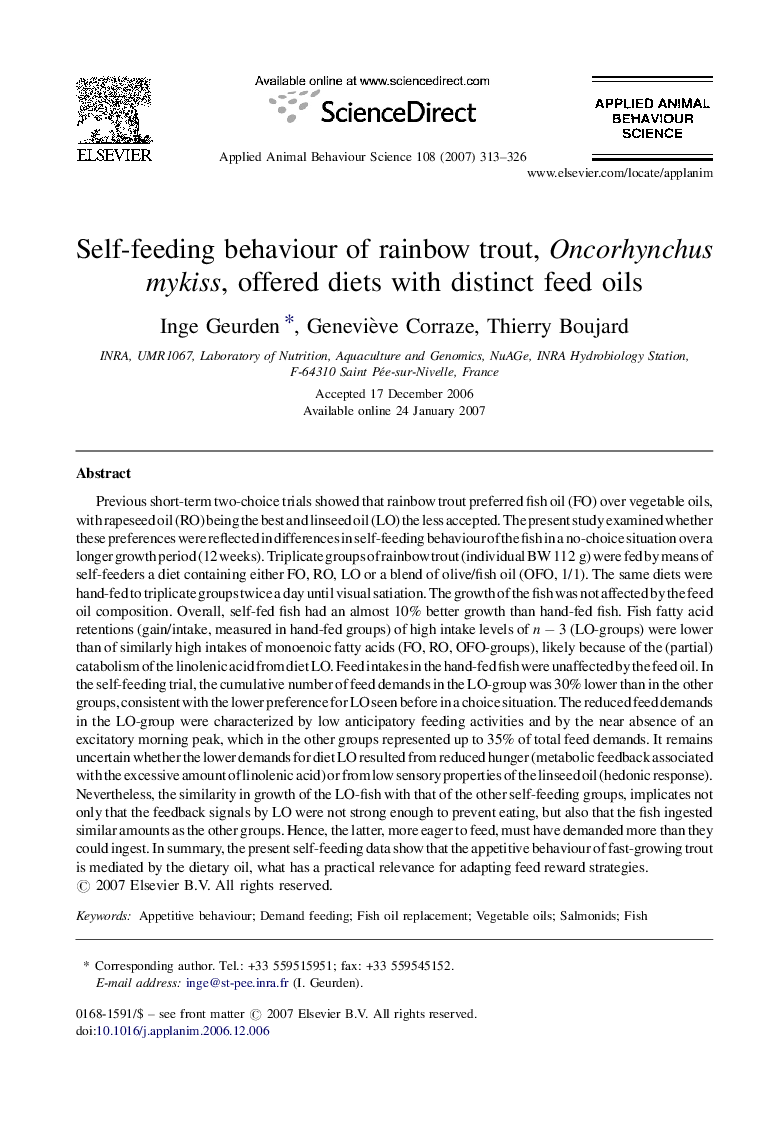| کد مقاله | کد نشریه | سال انتشار | مقاله انگلیسی | نسخه تمام متن |
|---|---|---|---|---|
| 4524146 | 1625427 | 2007 | 14 صفحه PDF | دانلود رایگان |

Previous short-term two-choice trials showed that rainbow trout preferred fish oil (FO) over vegetable oils, with rapeseed oil (RO) being the best and linseed oil (LO) the less accepted. The present study examined whether these preferences were reflected in differences in self-feeding behaviour of the fish in a no-choice situation over a longer growth period (12 weeks). Triplicate groups of rainbow trout (individual BW 112 g) were fed by means of self-feeders a diet containing either FO, RO, LO or a blend of olive/fish oil (OFO, 1/1). The same diets were hand-fed to triplicate groups twice a day until visual satiation. The growth of the fish was not affected by the feed oil composition. Overall, self-fed fish had an almost 10% better growth than hand-fed fish. Fish fatty acid retentions (gain/intake, measured in hand-fed groups) of high intake levels of n − 3 (LO-groups) were lower than of similarly high intakes of monoenoic fatty acids (FO, RO, OFO-groups), likely because of the (partial) catabolism of the linolenic acid from diet LO. Feed intakes in the hand-fed fish were unaffected by the feed oil. In the self-feeding trial, the cumulative number of feed demands in the LO-group was 30% lower than in the other groups, consistent with the lower preference for LO seen before in a choice situation. The reduced feed demands in the LO-group were characterized by low anticipatory feeding activities and by the near absence of an excitatory morning peak, which in the other groups represented up to 35% of total feed demands. It remains uncertain whether the lower demands for diet LO resulted from reduced hunger (metabolic feedback associated with the excessive amount of linolenic acid) or from low sensory properties of the linseed oil (hedonic response). Nevertheless, the similarity in growth of the LO-fish with that of the other self-feeding groups, implicates not only that the feedback signals by LO were not strong enough to prevent eating, but also that the fish ingested similar amounts as the other groups. Hence, the latter, more eager to feed, must have demanded more than they could ingest. In summary, the present self-feeding data show that the appetitive behaviour of fast-growing trout is mediated by the dietary oil, what has a practical relevance for adapting feed reward strategies.
Journal: Applied Animal Behaviour Science - Volume 108, Issues 3–4, 25 December 2007, Pages 313–326